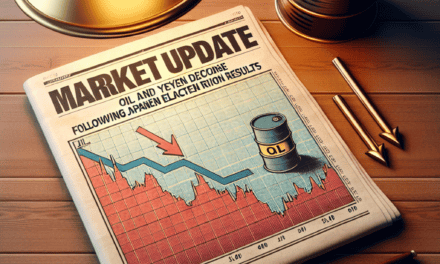“Trump’s Triumph: Shaking Up Global Economic Forecasts”
Introduction
Donald Trump’s unexpected victory in the U.S. presidential election has sent shockwaves through global financial markets, upending previously held expectations regarding central bank policies and interest rate trajectories. Investors and policymakers worldwide are grappling with the potential economic implications of Trump’s proposed fiscal policies, which include significant tax cuts and increased infrastructure spending. These measures are anticipated to stimulate economic growth and potentially lead to inflationary pressures, prompting a reevaluation of the global interest rate landscape. As markets adjust to the new political reality, the anticipated path of rate cuts by central banks, particularly in developed economies, faces significant disruption, with potential shifts towards tighter monetary policies to counteract inflation risks. This unexpected turn of events underscores the intricate interplay between political developments and economic strategies on the global stage.
Impact Of Trump’s Victory On Global Financial Markets
The unexpected victory of Donald Trump in the 2016 United States presidential election sent ripples through global financial markets, significantly altering the landscape of monetary policy expectations worldwide. Initially, markets were poised for a period of uncertainty, as Trump’s campaign rhetoric suggested a departure from established economic policies. However, as the dust settled, it became evident that his presidency would have profound implications on global rate-cut expectations, reshaping the strategies of central banks across the world.
In the immediate aftermath of Trump’s election, financial markets experienced heightened volatility. Investors, grappling with the uncertainty of a Trump administration, initially sought refuge in safe-haven assets such as gold and government bonds. However, as Trump’s economic agenda began to take shape, characterized by promises of tax cuts, deregulation, and substantial infrastructure spending, market sentiment shifted dramatically. The prospect of fiscal stimulus under Trump’s leadership fueled expectations of accelerated economic growth and inflation in the United States, prompting a reassessment of monetary policy trajectories.
One of the most significant impacts of Trump’s victory was observed in the bond markets. The anticipation of increased government spending and potential inflationary pressures led to a sharp rise in U.S. Treasury yields. This surge in yields reverberated across global bond markets, compelling investors to recalibrate their expectations for interest rates. As a result, central banks worldwide faced mounting pressure to reconsider their accommodative monetary policies, which had been in place since the global financial crisis.
In the United States, the Federal Reserve found itself at the forefront of this shift. Prior to the election, the Fed had been on a cautious path of gradual rate hikes, mindful of the fragile global economic recovery. However, with Trump’s victory and the subsequent market reaction, the Fed was compelled to accelerate its normalization process. The anticipation of fiscal stimulus and its potential inflationary impact provided the impetus for the Fed to raise interest rates more aggressively than previously anticipated.
The ripple effects of Trump’s victory were not confined to the United States. Across the Atlantic, the European Central Bank (ECB) faced its own set of challenges. The rise in U.S. yields exerted upward pressure on European bond yields, complicating the ECB’s efforts to maintain accommodative monetary conditions. As a result, the ECB was forced to reassess its quantitative easing program and consider the timing of its eventual tapering. Similarly, in Asia, central banks in countries such as Japan and China had to navigate the complexities of a stronger U.S. dollar and the potential for capital outflows, which further complicated their monetary policy decisions.
Moreover, Trump’s victory also had implications for emerging markets, which had been beneficiaries of low global interest rates and abundant liquidity. The prospect of higher U.S. interest rates and a stronger dollar posed significant challenges for these economies, as it increased the cost of borrowing and heightened the risk of capital flight. Consequently, central banks in emerging markets were compelled to adopt a more cautious stance, balancing the need to support growth with the imperative to maintain financial stability.
In conclusion, Donald Trump’s unexpected victory in the 2016 U.S. presidential election had a profound impact on global financial markets, disrupting rate-cut expectations and reshaping monetary policy trajectories worldwide. The anticipation of fiscal stimulus and its potential inflationary effects prompted a reassessment of interest rate paths, compelling central banks to navigate a new economic landscape. As markets adjusted to the realities of a Trump presidency, the global financial system entered a period of recalibration, with far-reaching implications for economies around the world.
How Trump’s Policies Could Influence Central Bank Decisions
Donald Trump’s unexpected victory in the 2016 U.S. presidential election sent ripples through global financial markets, leading to a reassessment of economic policies and their potential impact on central bank decisions worldwide. As markets grappled with the implications of a Trump presidency, one of the most immediate effects was the disruption of global rate-cut expectations. This shift in sentiment was largely driven by Trump’s proposed economic policies, which promised to reshape the fiscal landscape and, consequently, influence central bank strategies.
Initially, Trump’s campaign rhetoric focused on significant tax cuts, increased infrastructure spending, and deregulation. These policies were anticipated to stimulate economic growth, potentially leading to higher inflationary pressures. As a result, investors began to recalibrate their expectations, moving away from the previously anticipated rate cuts by central banks. Instead, the focus shifted towards the possibility of rate hikes, particularly in the United States, as the Federal Reserve would need to counteract any inflationary trends spurred by fiscal expansion.
Moreover, Trump’s protectionist trade policies, including the renegotiation of trade agreements and the imposition of tariffs, added another layer of complexity to the global economic outlook. These measures were expected to disrupt international trade flows, potentially leading to increased costs for imported goods and contributing to inflationary pressures. Central banks, particularly those in open economies heavily reliant on trade, had to consider these factors when formulating their monetary policies. The potential for trade tensions to escalate into trade wars further complicated the decision-making process, as central banks had to weigh the risks of slower global growth against domestic inflationary pressures.
In addition to fiscal and trade policies, Trump’s stance on deregulation, particularly in the financial sector, had implications for monetary policy. By reducing regulatory burdens, the Trump administration aimed to boost lending and investment, which could further stimulate economic activity. Central banks, therefore, had to assess the potential impact of increased financial sector activity on economic growth and inflation. This assessment was crucial in determining whether to maintain accommodative monetary policies or to begin tightening in response to a more robust economic environment.
Furthermore, Trump’s victory also influenced central bank decisions through its impact on currency markets. The U.S. dollar experienced significant volatility following the election, as investors reacted to the anticipated changes in fiscal and trade policies. A stronger dollar, driven by expectations of higher interest rates and economic growth, posed challenges for central banks in other countries. For instance, emerging market economies with dollar-denominated debt faced increased repayment costs, prompting their central banks to reconsider their monetary policy stances to stabilize their currencies and manage inflationary pressures.
In conclusion, Trump’s victory in the 2016 presidential election disrupted global rate-cut expectations by introducing a range of economic policies that had far-reaching implications for central bank decisions. The anticipated fiscal expansion, protectionist trade measures, deregulation efforts, and currency market volatility all contributed to a reassessment of monetary policy strategies worldwide. As central banks navigated this new economic landscape, they had to balance the risks of inflation against the need to support growth, ultimately leading to a more cautious approach to rate cuts and, in some cases, a shift towards tightening monetary policy. This complex interplay of factors underscored the profound influence of political developments on global economic dynamics and central bank decision-making processes.
The Future Of Interest Rates In A Trump-Led Economy
Donald Trump’s unexpected victory in the 2016 U.S. presidential election sent ripples through global financial markets, leading to a reassessment of interest rate expectations worldwide. As markets grappled with the implications of a Trump-led economy, the anticipated trajectory of interest rates underwent significant shifts. Initially, Trump’s campaign promises of tax cuts, deregulation, and substantial infrastructure spending fueled expectations of accelerated economic growth. This potential for increased fiscal stimulus suggested that inflationary pressures might rise, prompting central banks to reconsider their monetary policies.
In the United States, the Federal Reserve faced the immediate challenge of balancing these new fiscal policies with its mandate to maintain stable prices and maximum employment. Prior to the election, the Fed had signaled a gradual path of rate hikes, contingent on steady economic growth and moderate inflation. However, with Trump’s proposed economic agenda, the possibility of faster-than-expected inflation emerged, leading to speculation that the Fed might need to raise rates more aggressively to prevent the economy from overheating.
Simultaneously, global markets reacted to the prospect of a more protectionist U.S. trade policy under Trump. Concerns about potential trade wars and their impact on global growth added another layer of complexity to the interest rate outlook. Countries heavily reliant on trade with the U.S. began to reassess their own monetary policies, considering the potential need to adjust rates to counteract any negative economic impacts. This uncertainty contributed to increased volatility in currency markets, as investors sought to anticipate the direction of future rate changes.
In Europe, the European Central Bank (ECB) faced its own set of challenges. With the Eurozone still recovering from the sovereign debt crisis, the ECB had maintained an accommodative monetary stance to support growth and stave off deflation. However, the possibility of a stronger U.S. dollar and rising U.S. interest rates put pressure on the euro, complicating the ECB’s efforts to manage its monetary policy effectively. The potential for capital outflows from emerging markets, driven by higher U.S. rates, also posed risks to global financial stability, prompting central banks in these regions to consider defensive rate hikes to protect their currencies.
Moreover, Trump’s victory highlighted the interconnectedness of global economies and the influence of U.S. policy decisions on international monetary dynamics. As markets adjusted to the new political landscape, central banks around the world found themselves navigating a complex web of economic signals and geopolitical uncertainties. The need for coordinated policy responses became increasingly apparent, as isolated actions could exacerbate volatility and undermine global economic stability.
In conclusion, Trump’s victory in the 2016 election disrupted global rate-cut expectations, prompting a reevaluation of monetary policies across the world. The potential for increased fiscal stimulus in the U.S., coupled with concerns about protectionist trade policies, created a challenging environment for central banks. As they sought to balance domestic economic conditions with global financial stability, the future of interest rates in a Trump-led economy remained uncertain. This period underscored the importance of adaptability and coordination among central banks, as they worked to navigate the evolving economic landscape and mitigate potential risks to growth and stability.
Analyzing The Global Economic Reactions To Trump’s Win
The unexpected victory of Donald Trump in the 2016 United States presidential election sent ripples through global financial markets, significantly altering the landscape of economic expectations worldwide. As investors and policymakers grappled with the implications of a Trump presidency, one of the most immediate and profound impacts was on global interest rate expectations. Prior to the election, many central banks around the world were poised to continue or even accelerate their rate-cutting strategies in response to sluggish economic growth and persistently low inflation. However, Trump’s win introduced a new set of variables that disrupted these plans.
Initially, the markets reacted with volatility, as uncertainty loomed over Trump’s economic policies, which were largely uncharted territory. His campaign promises of tax cuts, deregulation, and substantial infrastructure spending suggested a potential boost to U.S. economic growth. This prospect led to a rapid reassessment of inflation expectations, as investors anticipated that such fiscal stimulus could lead to higher demand and, consequently, upward pressure on prices. As a result, bond yields surged, reflecting the market’s anticipation of higher inflation and the possibility of a more aggressive monetary policy stance from the Federal Reserve.
The shift in U.S. interest rate expectations had a cascading effect on global central banks. In Europe, the European Central Bank (ECB) faced a dilemma. While the eurozone was still grappling with weak growth and deflationary pressures, the prospect of a stronger U.S. dollar and rising U.S. interest rates complicated the ECB’s policy calculus. A stronger dollar could lead to a weaker euro, potentially boosting European exports but also importing inflation. Consequently, the ECB had to weigh the benefits of continued monetary easing against the risks of capital outflows and financial instability.
Similarly, in Asia, central banks found themselves in a precarious position. Countries like Japan, which had been pursuing aggressive monetary easing to combat deflation, had to reconsider their strategies. The Bank of Japan, in particular, faced the challenge of maintaining its yield curve control policy in the face of rising global yields. Meanwhile, emerging markets, which had benefited from low global interest rates and abundant liquidity, suddenly faced the threat of capital flight as investors sought higher returns in the U.S. This shift forced many emerging market central banks to rethink their rate-cutting trajectories, as they sought to defend their currencies and stabilize their economies.
In addition to these immediate reactions, Trump’s victory also prompted a broader reevaluation of global economic policies. The potential for increased protectionism under Trump’s “America First” agenda raised concerns about the future of international trade and its implications for global growth. Central banks, therefore, had to consider not only the direct effects of U.S. fiscal policy but also the potential disruptions to global supply chains and trade relationships.
In conclusion, Donald Trump’s unexpected electoral victory in 2016 significantly disrupted global rate-cut expectations, as markets and central banks around the world scrambled to adjust to a new economic reality. The anticipated fiscal stimulus in the U.S. led to a reassessment of inflation and interest rate trajectories, with far-reaching implications for monetary policy across the globe. As central banks navigated this complex landscape, they were forced to balance domestic economic conditions with the broader global shifts initiated by the Trump administration’s policy agenda. This period marked a pivotal moment in the interplay between fiscal and monetary policy on the world stage, highlighting the intricate connections that define the global economy.
Trump’s Economic Agenda: A Challenge For Global Rate Cuts
Donald Trump’s unexpected victory in the 2016 U.S. presidential election sent ripples through global financial markets, significantly altering the landscape of monetary policy expectations worldwide. As markets grappled with the implications of Trump’s economic agenda, central banks around the globe found themselves reassessing their strategies, particularly concerning interest rate cuts. Trump’s proposed policies, characterized by fiscal expansion, deregulation, and protectionism, introduced a new set of variables that challenged the prevailing assumptions about the trajectory of global interest rates.
Initially, Trump’s victory was met with uncertainty and volatility in financial markets. However, as investors began to digest the potential impact of his economic policies, a clearer picture emerged. Central to Trump’s agenda was a promise of substantial fiscal stimulus, including tax cuts and increased infrastructure spending. These measures were anticipated to boost economic growth and inflation in the United States, prompting a reassessment of the Federal Reserve’s monetary policy stance. Consequently, expectations shifted from further rate cuts to potential rate hikes, as the Fed would likely need to counteract inflationary pressures stemming from fiscal expansion.
This shift in U.S. monetary policy expectations had profound implications for central banks worldwide. In the years leading up to Trump’s election, many central banks had adopted accommodative monetary policies, including rate cuts, to combat sluggish growth and low inflation. However, the prospect of a more aggressive Fed tightening cycle complicated these efforts. As U.S. interest rates rose, capital flows began to shift, with investors seeking higher returns in American markets. This dynamic exerted upward pressure on global interest rates, making it more challenging for other central banks to justify further rate cuts.
Moreover, Trump’s protectionist rhetoric and trade policies added another layer of complexity to the global economic environment. The imposition of tariffs and the renegotiation of trade agreements introduced uncertainty into international trade relations, potentially disrupting global supply chains and dampening economic growth. Central banks, already grappling with the implications of a stronger U.S. dollar and rising interest rates, now had to consider the potential fallout from escalating trade tensions. This environment made it increasingly difficult for central banks to pursue aggressive rate cuts without risking capital outflows and currency depreciation.
In addition to these challenges, Trump’s deregulatory agenda and emphasis on energy independence had implications for global commodity markets. The potential for increased U.S. oil production and reduced regulatory burdens on industries such as finance and manufacturing suggested a shift in the global economic balance. Central banks, particularly those in emerging markets reliant on commodity exports, had to navigate these changes carefully. The prospect of lower commodity prices and increased competition from U.S. producers added another layer of complexity to their monetary policy decisions.
In conclusion, Donald Trump’s victory in the 2016 U.S. presidential election disrupted global rate-cut expectations by introducing a new set of economic policies that challenged the status quo. His fiscal expansion plans, protectionist trade policies, and deregulatory agenda prompted a reevaluation of monetary policy strategies worldwide. As central banks grappled with the implications of a more aggressive U.S. monetary policy stance, rising global interest rates, and increased trade tensions, the path forward became increasingly uncertain. This period marked a significant turning point in global economic policy, highlighting the interconnectedness of national economies and the far-reaching impact of political developments on monetary policy decisions.
The Role Of U.S. Politics In Shaping Global Monetary Policies
The unexpected victory of Donald Trump in the 2016 U.S. presidential election sent ripples through global financial markets, significantly altering the landscape of monetary policy expectations worldwide. Prior to the election, many central banks were poised to continue or even accelerate their rate-cutting strategies in response to sluggish economic growth and persistently low inflation. However, Trump’s triumph introduced a new set of variables that compelled policymakers to reassess their strategies.
One of the primary factors influencing this shift was Trump’s economic agenda, which promised substantial fiscal stimulus through tax cuts and increased infrastructure spending. This prospect of fiscal expansion led to a reassessment of inflationary pressures, as increased government spending was expected to boost demand and, consequently, prices. As a result, central banks, particularly the Federal Reserve, faced the challenge of balancing the need to support economic growth with the risk of overheating the economy. This delicate balancing act necessitated a reevaluation of the previously anticipated trajectory of interest rates.
Moreover, Trump’s protectionist trade policies, including the renegotiation of trade agreements and the imposition of tariffs, introduced additional uncertainty into the global economic environment. These policies had the potential to disrupt international trade flows, leading to volatility in currency markets and impacting global supply chains. Central banks, therefore, had to consider the potential ramifications of these policies on their domestic economies, further complicating their monetary policy decisions.
In the context of these developments, the Federal Reserve’s approach to interest rates became a focal point for global markets. The anticipation of fiscal stimulus and its inflationary implications led the Fed to adopt a more hawkish stance, signaling a faster pace of rate hikes than previously expected. This shift had a cascading effect on other central banks, particularly those in emerging markets, which were compelled to adjust their own policies in response to the strengthening U.S. dollar and the potential for capital outflows.
The European Central Bank (ECB), for instance, faced the challenge of managing its monetary policy in the wake of a stronger dollar and rising U.S. interest rates. While the ECB had been pursuing an accommodative policy to combat low inflation and stimulate growth, the changing global dynamics necessitated a careful reassessment of its strategy. Similarly, central banks in Asia and Latin America had to navigate the complexities of maintaining economic stability amid shifting capital flows and exchange rate pressures.
In addition to these economic considerations, Trump’s victory also underscored the broader influence of U.S. politics on global monetary policies. The election highlighted the interconnectedness of global economies and the extent to which political developments in one country can reverberate across the world. Central banks, therefore, found themselves in a position where they had to not only respond to domestic economic conditions but also anticipate and adapt to the geopolitical landscape shaped by U.S. policy decisions.
In conclusion, Trump’s victory in the 2016 U.S. presidential election served as a catalyst for a significant reevaluation of global monetary policy expectations. The combination of anticipated fiscal stimulus, protectionist trade policies, and the resulting economic uncertainties compelled central banks to reassess their strategies in a rapidly changing environment. This episode highlighted the intricate relationship between U.S. politics and global monetary policies, underscoring the need for central banks to remain agile and responsive to both domestic and international developments.
Trump’s Victory: A Turning Point For Global Economic Strategies
Donald Trump’s unexpected victory in the 2016 U.S. presidential election marked a significant turning point for global economic strategies, particularly in the realm of monetary policy. Prior to the election, many central banks around the world were poised to continue or even accelerate their rate-cutting strategies in response to sluggish economic growth and persistent low inflation. However, Trump’s win introduced a new set of variables that disrupted these expectations and forced policymakers to reassess their strategies.
One of the primary reasons for this shift was Trump’s economic agenda, which promised substantial fiscal stimulus through tax cuts and increased infrastructure spending. This approach was anticipated to boost economic growth and potentially lead to higher inflation in the United States. As a result, the Federal Reserve, which had been cautious about raising interest rates due to tepid economic indicators, found itself under pressure to adjust its policy stance. The prospect of a more robust U.S. economy led to expectations of a faster pace of rate hikes, which in turn influenced global financial markets.
The ripple effects of Trump’s victory were felt far beyond the United States. In Europe, the European Central Bank (ECB) had been grappling with its own set of challenges, including weak growth and deflationary pressures. The potential for a stronger U.S. economy and a more aggressive Federal Reserve policy stance complicated the ECB’s efforts to maintain accommodative monetary conditions. The euro faced upward pressure as investors anticipated higher U.S. interest rates, which could have undermined the ECB’s attempts to stimulate the eurozone economy.
Similarly, in Asia, central banks were forced to reconsider their strategies. Japan, which had been engaged in aggressive monetary easing under the leadership of the Bank of Japan, faced the prospect of a stronger yen as global investors sought safe-haven assets in response to potential U.S. policy shifts. This scenario threatened to derail Japan’s efforts to combat deflation and stimulate growth. Meanwhile, in emerging markets, the anticipation of higher U.S. interest rates led to capital outflows and currency depreciation, further complicating the monetary policy landscape.
In addition to these direct impacts, Trump’s victory also introduced a degree of uncertainty into global trade relations. His protectionist rhetoric and promises to renegotiate trade agreements raised concerns about potential disruptions to global supply chains and trade flows. This uncertainty added another layer of complexity for central banks, which had to consider the potential economic fallout from any significant changes in trade policy.
As central banks around the world grappled with these new challenges, the need for coordination and communication became increasingly apparent. The interconnected nature of the global economy meant that policy decisions in one country could have far-reaching implications for others. In this context, forums such as the G20 and the International Monetary Fund played a crucial role in facilitating dialogue and cooperation among policymakers.
In conclusion, Donald Trump’s victory in the 2016 U.S. presidential election served as a catalyst for a reevaluation of global economic strategies, particularly in the realm of monetary policy. The anticipated shift in U.S. fiscal and monetary policy introduced new dynamics that disrupted rate-cut expectations and forced central banks to adapt to a rapidly changing environment. As the world continues to navigate these complexities, the importance of international cooperation and communication remains paramount in ensuring global economic stability.
Q&A
1. **What was the immediate market reaction to Trump’s victory in the 2016 U.S. presidential election?**
Financial markets experienced significant volatility, with stock futures initially plunging and then recovering, while bond yields rose sharply.
2. **How did Trump’s victory impact expectations for U.S. interest rates?**
Trump’s proposed fiscal policies, including tax cuts and infrastructure spending, led to expectations of higher inflation and growth, prompting markets to anticipate faster rate hikes by the Federal Reserve.
3. **What was the effect on global central banks’ rate-cut plans?**
The prospect of increased U.S. interest rates and inflation led to a reassessment of rate-cut plans by global central banks, as they considered the potential for capital outflows and currency depreciation.
4. **How did Trump’s policies influence inflation expectations?**
His policies were expected to boost economic growth and inflation, leading to a shift in market expectations towards higher future inflation rates.
5. **What was the impact on the U.S. dollar following the election?**
The U.S. dollar strengthened significantly as investors anticipated higher interest rates and economic growth under Trump’s administration.
6. **How did emerging markets react to Trump’s victory?**
Emerging markets faced pressure due to the stronger dollar and potential capital outflows, leading to concerns about their economic stability and growth prospects.
7. **What sectors were expected to benefit from Trump’s proposed policies?**
Sectors such as infrastructure, defense, and financial services were expected to benefit from increased government spending and deregulation under Trump’s administration.
Conclusion
Donald Trump’s victory in the 2016 U.S. presidential election led to significant disruptions in global rate-cut expectations. Markets anticipated that his proposed fiscal policies, including tax cuts and increased infrastructure spending, would stimulate economic growth and potentially lead to higher inflation. This shift in economic outlook prompted central banks worldwide to reconsider their monetary policies, moving away from further rate cuts and towards potential rate hikes to counteract inflationary pressures. Consequently, Trump’s victory marked a turning point in global monetary policy, influencing central banks to adopt a more cautious approach in their rate-setting decisions.





